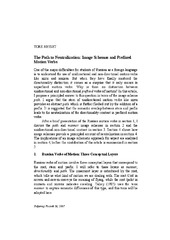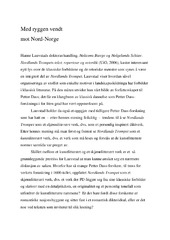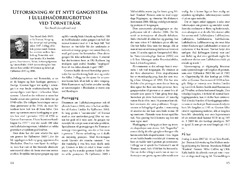Artikler, rapporter og annet (språk og kultur): Recent submissions
Now showing items 1341-1360 of 1477
-
The Path to Neutralization: Image Schemas and Prefixed Motion Verbs
(Journal article; Tidsskriftartikkel, 2007)One of the major difficulties for students of Russian as a foreign language is to understand the use of unidirectional and non-directional motion verbs like идти and ходить. But when they have finally mastered the directionality distinction it comes as a surprise that it only occurs in unprefixed motion verbs. Why is there no distinction between unidirectional and non-directional prefixed verbs ... -
Problemy izucenija severnorusskogo slova DAK: dostizenija i nedostatki
(Journal article; Tidsskriftartikkel, 2002)The word dak is one of several highly frequent particles, used in most Northern Russian and some Siberian dialects. It can occur sentence initially, sentence internally and sentence finally to connect two parts of the discourse, such as words, sentences, and presuppositions. This article describes the advantages and shortcomings of six different perspectives which have been used to describe ... -
Med ryggen vendt mot Nord-Norge : en kommentar til Hanne Lauvstads Petter Dass-lesning
(Journal article; Tidsskriftartikkel; Peer reviewed, 2007)Artikkelen tar utgangspunkt i Hanne Lauvstads doktoravhandling "Helicons Bierge og Helgelands Schiær. Nordlands Trompets tekst, repertoar og retorikk" -
Eeva Törmänen eller Eva Dørmænen? Møte mellom finsk og norsk namnesystem i Noreg
(Journal article; Tidsskriftartikkel; Peer reviewed, 2007-08)Artikkelen gir ein analyse av personnamna til etterkommarane av finske innvandrarar i Noreg på grunnlag av opplysningar i folketeljinga frå 1900. Materialet omfattar namna på dei som er oppførte med finsk etnisitet, og som er fødde i Noreg. Dette materialet består av to delar: Grue-materialet (412 personar frå Grue Finnskog i Sør-Noreg) og kvenmaterialet med namnedata for 3840 kvenar frå Finnmark ... -
Game-boards and gaming-pieces in the Northern European Iron Age
(Journal article; Tidsskriftartikkel, 2006) -
Dionysos in the underworld. An interpretation of the Toledo krater
(Journal article; Tidsskriftartikkel, 2006) -
Nansens "På ski over Grønland"
(Journal article; Tidsskriftartikkel, 2006) -
Forestillinger om familien(e) i norsk samtidslitteratur med utgangspunkt i Tom Egil Hvervens bok:"Å lese etter familien/forsøk om norsk litteratur på 1990-tallet" (Tiden 1999)
(Journal article; Tidsskriftartikkel, 2006) -
Å snakke med de døde. En studie i Ingvar Ambjørnsens novelle "Skallene"
(Journal article; Tidsskriftartikkel, 2006) -
Utforskning av et nytt gangsystem i Lullehačorrugrottan ved Torneträsk
(Journal article; Tidsskriftartikkel, 2007-06)The Lullehačorrugrottan cave in the Torneträsk area of northern Sweden was originally surveyed to 1145 m by Gunnar Rasmusson 50 years ago. Later surveys in 2003 added 267 m of new cave passages (grade 2). In March 2007 a Norwegian / Swedish joint expedition explored and partly surveyed the continuation of one of the passages discovered in 2003. The benefit of winter caving is low water level, because ... -
Christa Wolf’s "What Remains". One document or a document unit?
(Conference object; Konferansebidrag, 2003-08)Christa Wolf – one of the most famous East German writers – published a little story called What remains in the summer of 1990. Written in the late seventies under the GDR regime but first published after the opening of the Berlin Wall, What remains caused a great stir in the almost reunified Germany known as the Christa-Wolf-Debate. Especially in big German newspapers like Die Zeit or Frankfurter ... -
The notion of text and the notion of document. What difference does it make?
(Conference object; Konferansebidrag, 2004-10)The notion of text has a long tradition inside the human science. A broad definition of this concept considers all man-made products as systems of signs and thereby as texts; but often not “as the physical manifestation as such, but as the abstract representation of a work” (Gunder: 2001, 86). Considering that everything – including sculpture, music, photography and film – can become a text, either ... -
Prepositions in Krio
(Journal article; Tidsskriftartikkel, 2006)This paper is part of Peter Svenonius’ Adposition Seminar at the University of Tromsø which was taught in 2005-2006. The main focus was the distinction between locative path and locative place constructions. The aim of this paper is descriptive in nature and focuses on the complete prepositional system of Krio, an English-based Creole language spoken in Sierra Leone. The paper starts with a general ... -
Goal-source asymmetry and Russian spatial prefixes
(Journal article; Tidsskriftartikkel, 2006)In this paper, I draw on data from Russian to argue for the asymmetry between Goal and Source prepositional phrases. Source prepositional phrases are structurally ambiguous; they can occur both as arguments and adjuncts in certain syntactic contexts. Goal prepositional phrases are unambiguously arguments. I claim that Source prepositions have lexically specified semantics, which determines their ... -
Directed motion and non-predicative path P in Korean
(Journal article; Tidsskriftartikkel, 2006)In this paper, I argue that an atelic path PP headed by -(u)lo ‘toward’ in Korean is an argument of a directed motion verb on a par with its telic counterpart headed by the locative -ey ‘(be) AT’. I further argue that, despite having the same argumental status, the atelic path PP is distinguished from the goal-marking locative PP in terms of an entailment of a result state and predicativity; while ... -
Aspect and verbal preposition
(Journal article; Tidsskriftartikkel, 2006)In this paper, we explore some previously unanalysed interactions between verbal aktionsart and prepositional complementation in Norwegian, namely the alternations between a DP object and PP complements with på ‘on/at’ and til ‘to/at’. We argue that a simple account based on [±telic] or [±quantized] features cannot be correct. Instead, we generalize the notion of path and homomorphism, and integrate ... -
Body part nouns in expressions of location in French
(Journal article; Tidsskriftartikkel, 2006)In relation to inanimates, nouns that normally denote body parts when constructed in relation to an animate whole (pied ‘foot’, tête ‘head’, etc.) lose their literal meaning in French and acquire instead a spatial interpretation. This paper argues that spatial part Ns in French divide into two coherent groups with distinct properties: fixed spatial part terms, which denote concrete, perceptible ... -
The axial part phrase in Japanese
(Journal article; Tidsskriftartikkel, 2006)In this paper, I investigate the categorial status of spatial terms in locative/directional expressions in Japanese. I will show that a certain class of spatial terms have a distinct categorial status from both regular postpositions and nouns. On one hand, syntactic diagnostics such as doubling, coordination by to, and co-occurrence with demonstratives indicate that these spatial terms belong to a ... -
Categorizing adpositions in Kîîtharaka
(Journal article; Tidsskriftartikkel, 2006)In this paper, I discuss the categorial status of Kîîtharaka adpositions. I demonstrate that there are two main classes of adpositions(to be referred to as Class A and Class B). Class A adpositions are syntactic heads and they belong to the functional lexical category P. Class B adpositions are a phrasal P category with a nominal component. They therefore spell out a complex structure than adpositional ... -
Persian preposition classes
(Journal article; Tidsskriftartikkel, 2006)In this paper I present the prepositional system in Persian. I show that Persian prepositions can be divided into three classes (Class 1, Class 2a and Class 2b) which exhibit distinct syntactic behavior. Then I examine the question of the categorial status of Class 2 prepositions and demonstrate that they are not to be regarded as nouns. Finally I present the extended PP projection of Persian spatial ...


 English
English norsk
norsk


















